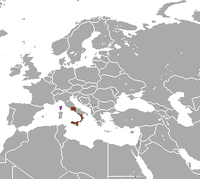Corsica hare
| Corsica hare | ||||||||||||
|---|---|---|---|---|---|---|---|---|---|---|---|---|
| Systematics | ||||||||||||
|
||||||||||||
| Scientific name | ||||||||||||
| Lepus corsicanus | ||||||||||||
| De Winton , 1898 |
The Corsican hare ( Lepus corsicanus ), also known as the Italian hare or the Apennine hare , is a species of mammal from the rabbit family (Leporidae). Despite its name, it is native to central and southern Italy, including Sicily , and was introduced to Corsica . The IUCN classifies the species as endangered ("vulnerable").
Mark
The Corsican hare is slightly smaller and lighter than the similar field hare , but the ears and hind feet are longer in relation to the body. The head-trunk length is 441–612 mm, the tail length 66–112 mm, the length of the hind feet 114–135 mm and the ear length 90–126 mm. The animals weigh 1.8-3.8 kg. Compared to the brown hare, the fur is gray on the top and more beige-brown on the flanks, the wool hair has a gray base. The underside is white.
distribution and habitat
The species is endemic to Italy . The small distribution area extends from the central northwest to the south of Italy and includes Sicily , the exact distribution is still often unclear. On the eponymous island of Corsica , the Corsican hare was probably introduced between the 14th and 17th centuries and was thought to be extinct again in the mid-1980s. In the years 2000 and 2001, however, the occurrence of the species was again proven beyond doubt by several dead finds.
Due to habitat destruction and competition with the brown hare, the species on the Italian peninsula is largely restricted to mountainous regions and only occurs in the hilly and lowlands where the brown hare is rare or - as in Sicily - absent. The species inhabits semi-open landscapes with bushes and deciduous forests as well as open areas that can also be used for agriculture. It occurs from sea level up to 2000 m, on Etna also up to 2400 m. In contrast to the brown hare, Corsica hare also inhabit the Mediterranean maquis .
Way of life
Little information is available about the way of life of the species. In Sicily, Corsica hares feed on sourgrass family (Cyperaceae), rush family (Juncaceae), legumes (Leguminosae) and composites (Compositae) all year round . In spring and summer, sweet grasses (Gramineae) and labiatae are also eaten. During a study in the Gallipoli Cognato Piccole Dolomiti Lucane regional park in the Basilicata region , southern Italy, a comprehensive analysis of the composition of the food was carried out using rabbit excrement pills. A total of 62 different plant species were identified, including numerous herbs such as Trifolium pratense , Brachypodium sylvaticum or Festuca arundinacea . In the spring, the proportion of grasses is comparatively high (37%), the diversity of the food is low at this time of the year. In the other seasons and especially in autumn, the proportion of fruits such as plums, pears and apples increases, which makes up about 27% in autumn.
Systematics
The Corsica hare was first described as an independent species of the genus Lepus by William Edward de Winton in 1898 , but was later assigned to the European hare ( Lepus europaeus ) as a subspecies. However, on the basis of morphological and molecular biological studies, it was recognized again as an independent species in the late 1990s.
Existence and endangerment
On the Italian mainland, the Corsica hare is considered endangered ("endangered"). The populations are mostly spatially isolated from one another, which probably means that there is hardly any genetic exchange and the species is rare there overall. Existing threats are the ongoing destruction of the habitat, the introduction or replenishment of the competing brown hare and the unintentional hunting through confusion with it. In Sicily, however, the species is widespread and at least locally common. Overall, the IUCN classifies the species as endangered ("vulnerable").
supporting documents
- ↑ a b c Lepus Corsicanus in the endangered Red List species the IUCN 2009. Posted by: Angelici, FM, Randi, E., Riga, F. & Trocchi, V., 2008. Accessed on December 14 of 2009.
- ↑ Pierangelo Freschi, Simonetta Fascetti, Mauro Musto, Egidio Mallia, Carlo Cosentino, Rosanna Paolino: Diet of the Italian hare (Lepus corsicanus) in a semi-natural landscape of southern Italy. ( Memento of the original from March 4, 2016 in the Internet Archive ) Info: The archive link was inserted automatically and has not yet been checked. Please check the original and archive link according to the instructions and then remove this notice. Mammalia 1, 2015; P. 51–59 doi : 10.1515 / mammalia-2013-0117 (currently unavailable)
- ↑ Lucas A. Wauters, Giovanni Amori, Gaetano Aloise, Spartaco Gippoliti, Paolo Agnelli, Andrea Galimberti, Maurizio Casiraghi, Damiano Preatoni, Adriano Martinoli: New endemic mammal species for Europe: Sciurus meridionalis (Rodentia, Sciuridae). Hystrix, the Italian Journal of Mammalogy 28, 1. doi : 10.4404 / hystrix-28.1-12015
literature
- S. Aulagnier, P. Haffner, AJ Mitchell-Jones, F. Moutou, J. Zima: The mammals of Europe, North Africa and the Middle East - The destination guide. Haupt Verlag; Bern, Stuttgart, Vienna, 2009: pp. 160–161. ISBN 978-3-258-07506-8
- AJ Mitchell-Jones, G. Amori, W. Bogdanowicz, B. Krystufek, PJH Reijnders, F. Spitzenberger, M. Stubbe, JBM Thissen, V. Vohralik, J. Zima: The Atlas of European Mammals. Poyser, London, 1999: pp. 164-165. ISBN 0-85661-130-1
Web links
- Lepus Corsicanus in the endangered Red List species the IUCN 2009. Posted by: Angelici, FM, Randi, E., Riga, F. & Trocchi, V., 2008. Accessed on December 14 of 2009.
